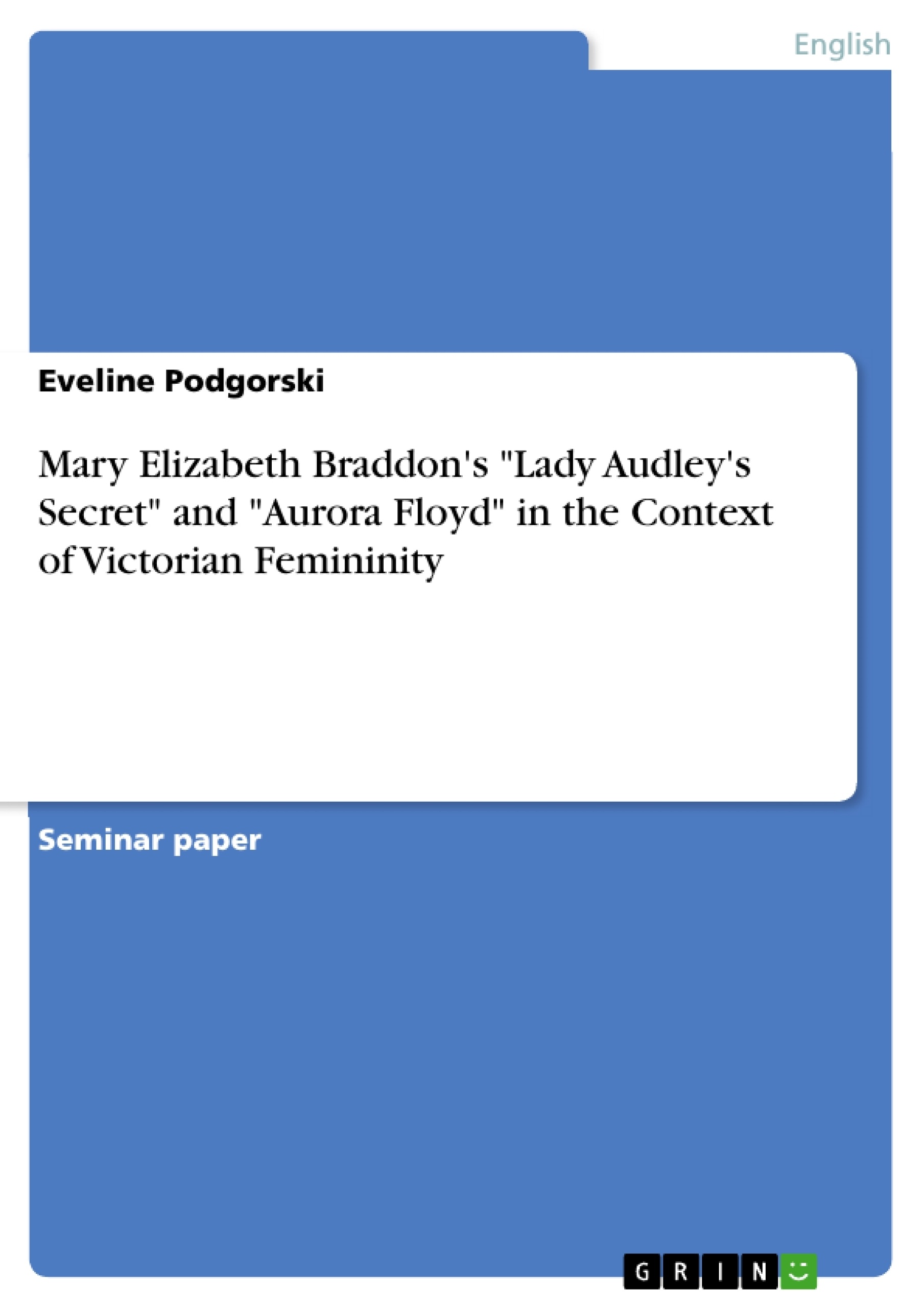In the context of the Hauptseminar “19th century sensation novels” we looked – among other texts – at two different sensation novels, one of them being Mary Elizabeth Braddon’s “Lady Audley’s Secret”, a sensation novel published in 1862. The sensation novel is a phenomenon originating in the 1860s and was mostly written for a great public. The aim was to evoke an intense as well as rather shocking response and strong feelings by dealing with subjects like mystery inside the domestic sphere. The sensation novel also went against common standards and taboos concerning class boundaries and the gender roles with actually no moral or didactic purpose.
This term paper does not only deal with the novel “Lady Audley’s Secret” as a sensation novel but examines it - together with Braddon’s other novel “Aurora Floyd” - in the context of Victorian Femininity. Firstly, I will give a short overview of the historical background of the so-called “Victorian Era” and a more detailed view of “Victorian Femininity”. Since the focus of this term paper is on femininity and the role of women, I will not go further into economics and expansion during the “Victorian Era”, but portray political events which were important for women at that time. This is followed by a description of the role of 19th century women in the domestic and public sphere, as well as an insight into education and work. Subsequently, the development of this gender role throughout this time is brought up in relation to an essay by Eliza Lynn Linton called “The Girl of the Period”.
Secondly, a short overview over Mary Elizabeth Braddon’s life and work is presented and reflected for it is rather uncommon for the Victorian Era in which she lived. Afterwards the plots of the two novels “Lady Audley’s Secret” and “Aurora Floyd” are presented and analysed in regard to traditional features of the detective novel and the idea of mystery in the novel. The summary of the two novels also serves as a background for further examination of the main protagonists, which, on the one hand, takes place later on in chapter 4.2 and 5.2 and, on the other hand, in chapter 6 where the characters will be compared and reflected in the context of Victorian Femininity. The term paper is concluded by a summary and a bibliography.
Inhaltsverzeichnis (Table of Contents)
- 1. Introduction
- 2. The Victorian Era and Victorian Femininity
- 2.1. Historical Background
- 2.2 Victorian Femininity
- 2.2.1 The Domestic Sphere
- 2.2.2 The Public Sphere
- 2.2.3 Work and Education
- 2.3 "The Girl of the Period"
- 3. Mary Elizabeth Braddon's Life and Work
- 4. "Lady Audley's Secret"
- 4.1 The Construction of the Plot
- 4.2. Helen Maldon
- 5. "Aurora Floyd"
- 5.1 The Construction of the Plot
- 5.2 Aurora Floyd
- 6. Aurora Floyd and Lady Audley in the Context of Victorian Femininity
- 7. Summary
Zielsetzung und Themenschwerpunkte (Objectives and Key Themes)
This term paper analyzes Mary Elizabeth Braddon's novels, "Lady Audley's Secret" and "Aurora Floyd," within the context of Victorian femininity. The main objective is to examine how these sensation novels portray and challenge the societal expectations and roles imposed on women during the Victorian era. * The historical background of Victorian England and its impact on women. * The contrasting ideals and realities of Victorian femininity in both the domestic and public spheres. * The portrayal of female characters who deviate from or conform to expected Victorian gender roles. * The exploration of themes of mystery and social transgression in Braddon's novels. * The use of sensation novel conventions to critique or reinforce Victorian social norms.Zusammenfassung der Kapitel (Chapter Summaries)
Chapter 1 introduces the paper's focus on Braddon's novels as examples of sensation fiction and their relationship to Victorian femininity. Chapter 2 provides historical context, exploring the Victorian era and its impact on women's lives, including their limited political influence and societal expectations. Chapter 2.2 delves into the roles of women in the domestic and public spheres. Chapter 3 offers a brief biography of Mary Elizabeth Braddon and her literary contributions. Chapters 4 and 5 summarize the plots of "Lady Audley's Secret" and "Aurora Floyd," respectively, highlighting their narrative structures and key characters. Chapter 6 analyzes the main female characters within the framework of Victorian femininity, examining their conformity to or rebellion against societal norms.Schlüsselwörter (Keywords)
Victorian femininity, sensation novels, Mary Elizabeth Braddon, Lady Audley's Secret, Aurora Floyd, domestic sphere, public sphere, gender roles, 19th-century England, social transgression, mystery.- Arbeit zitieren
- Eveline Podgorski (Autor:in), 2006, Mary Elizabeth Braddon's "Lady Audley's Secret" and "Aurora Floyd" in the Context of Victorian Femininity, München, GRIN Verlag, https://www.grin.com/document/119432



